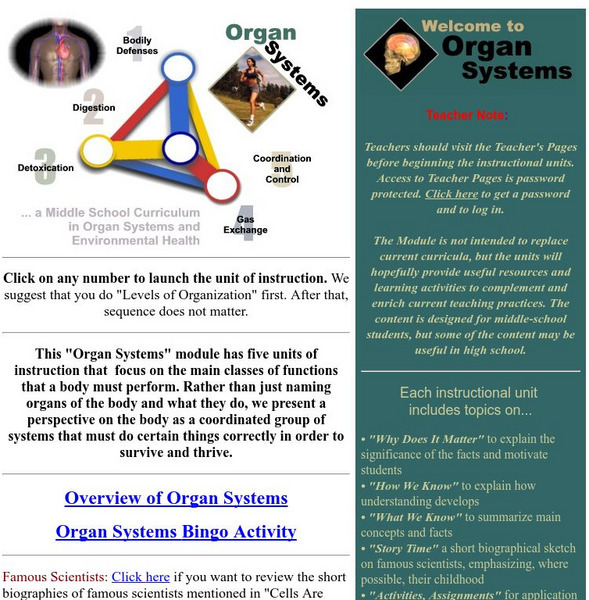Hi, what do you want to do?
Curated OER
Nanofibers: Why Go Small?
Students explore the surface ratio of an object. In this surface area to volume lesson students construct a data table, make calculations and create a graph.
Curated OER
World No Tobacco Day
In this world no tobacco day learning exercise, students read or listen to a passage, then match phrases, fill in the blanks, choose the correct words, unscramble words and sentences, write discussion questions and conduct a survey about...
Curated OER
Water Quality and Dissolved Oxygen
Students investigate the relationship between dissolved oxygen and organic materials and aquatic organisms. This is a 3-lesson series in which students explore dissolved oxygen and then design an experiment testing the effects of changes.
Curated OER
Ptolemy vs. Copernicus
Students list differences in the diagrams of a geocentric universe and a heliocentric universe. They students describe the religious impact of this change on man's conception of the universe and man's place within it. Students describe...
Curated OER
Snot: NC Summer Tour Lesson 2007
Students study various aspects of mucous. For this mucous lesson, students investigate the purpose of mucous. Students create fake mucous.
Curated OER
Water Quality Monitoring
Students comprehend the four parameters of water quality. They perform tests for salinity, dissolved oxygen, pH and clarity or turbidity. Students comprehend why scientists and environmental managers monitor water uality and aquatic...
Curated OER
Oysters: Impacts on Bay and Economy
Students are able to understand the history and economic impact of the oyster, as well as its function in the St. Mary's River Ecosystem. They are provided live specimen for each student to investigate and touch. Students are provided...
Curated OER
Integtrating Chinese Dance
Students investigate the concept of Chinese dance and how it developed. They practice some of the dances and conduct research the contributions of major choreographers. Students describe the history and cultural significance of each dance.
Curated OER
Crazy Crazy Bones
Students practice labeling the bones of a human skeleton. Students reword the song "Dry Bones" with the accurate names of the bones listed.
Curated OER
Hickory Dickory Dock: The Biological Clock
Young scholars investigate the effect of day length on animal migrations. They view a Powerpoint presentation, identify their own personal migrations and cues, answer discussion questions, and test a hypothesis about seasons.
Curated OER
Classification of Organisms
In this classification worksheet, students complete a crossword puzzle with 17 clues about vocabulary pertaining to the classification of organisms.
Curated OER
Classification of Organisms Crossword Answers
In this classification worksheet, students are provided with the answers to a crossword puzzle which has 17 clues pertaining to classification of organisms vocabulary.
Curated OER
Bird Beak Anatomy
Third graders participate in an activity to determine which tool will work the best to gather food. They create analogies about how the experiment relates to birds. They brainstorm about which adaptation helps or hurts the survival of an...
Curated OER
Celestial Seasonings
Young scholars review and discuss video about the relationships between the Earth, Sun and Moon. They create a HyperStudio stack about the Earth, Sun and Moon including created animation. Students present their finished product to the...
Curated OER
Online Research for a Genetic Disorder
In this genetics worksheet, high schoolers access a given website, chose a genetic disorder, and complete the 10 short answer questions about the disorder.
Curated OER
Research and Report
Learners use the Internet and other resources to locate, read and summarize information relevant to the Heart.
Curated OER
Feltboard Storytelling
Learners read African folktales and retell the story using feltboard. In this folktale lesson plan, students read the story Why the Sky is Far Awayand use feltboard to retell the stories.
Curated OER
Olympics
Students rotate through a variety of Olympic activities and record their results. Teams rotate through stations and practice units of measurement.
Curated OER
China
Learners explore the geography, culture and history of China. As a class, they discuss historical contributions to China, Confucius, and geographic features of the country. Pupils use the internet to answer questions about China.
Curated OER
Melodic Rhythms of India
Students listen to and dance to the music of India. After listening to the music again, they identify the different types of instruments playing the melody. They explain the tabla tarang and view photographs of people performing the music.
McGraw Hill
Mc Graw Hill Education: Bioscience: Sensory System [Pdf]
A 22-page textbook chapter identifying sensory systems of animals and humans for those studying how the various senses assist adaptation to environments. Investigates classes of environmental stimuli as well as gives an in-depth...
Texas A&M University
Peer Curricula: Organ Systems
This site gives five instructional units on organ systems: bodily defenses, digestion, detoxification, gas exchange, and coordination and control. Each unit is broken down into sections: "why does it matter," "how we know," "what we...
Alabama Learning Exchange
Alex: The Five Senses
In this lesson, students discover the five senses through literature and the Internet. Students create a presentation to demonstrate the five senses. Students also become aware that not everyone has all five senses.
SEDL
Sedl: Five Senses
Elementary students will gain great insight into the workings of our five senses through this collection of detailed, integrated lesson plans for grades K-3. Each lesson contains a list of needed materials, hands-on explorations...

























![Mc Graw Hill Education: Bioscience: Sensory System [Pdf] eBook Mc Graw Hill Education: Bioscience: Sensory System [Pdf] eBook](https://content.lessonplanet.com/knovation/original/455137-8656817b2aa2e7f4313d9c9c0b6654b0.jpg?1661557170)


